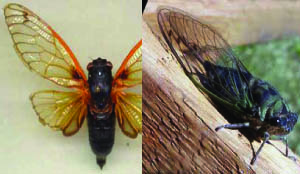 Wart Hog came arcoss a lovely natural beat in the milddle of the forest as he was looking at the trees that have been cut for farming. Wart Hog asked the tour guilde from this vellage what the insect was. From the explanation Wart Hog knew it was cicadas.
Wart Hog came arcoss a lovely natural beat in the milddle of the forest as he was looking at the trees that have been cut for farming. Wart Hog asked the tour guilde from this vellage what the insect was. From the explanation Wart Hog knew it was cicadas.
Commonly known locally as Nyenye, they are usually roasted and salted. Their shrill sound is a reminder for a meal to most Zambians.
Every season has its chorus — the thunder of a spring storm, the quiet chirp of songbirds on a still winter day, the many cicada species all have one thing in common. Their lifespan above ground is much shorter than their underground lives. Depending on the species, a cicada might emerge as often as annually or as infrequently as every 17 years, but they expire approximately five to six weeks later. Those several weeks are short but sweet for this remarkable insect.
If you live among large numbers of deciduous trees, it’s likely that cicadas are developing beneath the soil., cicadas have adapted well to leafy suburban living. While the majority of cicada species live among deciduous trees, some members of the family are found among pine trees or near swamps or the seaside. Cicadas dwelling beneath woodlands tend to have longer cycles than other species, but that doesn’t affect the time spent.
Female cicadas lay their eggs among small branches and tree twigs. Approximately six weeks later, these eggs hatch. The cicada nymphs fall onto the soil, burrowing underneath the ground. They feed on sap from the roots of trees, woody plants, grasses and herbal plants. Once underground, the nymphs of all species pass through four molts. The fifth and final molt occurs above ground, when they have emerged for their particular cycle.
Cicadas emerge in huge groups, numbering millions of insects. When the right periodical cycle occurs, cicadas begin emerging when the ground hits a certain nighttime temperature, as they appear after dark. Each cicada sheds that final skin on a tree, with the exoskeleton hardening within a few hours. “Stragglers” are those cicadas emerging in an off-year, usually involving relatively few insects. Although stragglers can appear in any year, they most often occur the year prior to a larger emergence or the succeeding season.
The song that fills the air a few days after cicadas emerge is that of males producing their mating calls. The life of the emerged male cicada consists primarily of singing, flying and mating. Short as the life of the aboveground cicada might be, it’s full of sex. Males and females mate continuously, with many partners. The female’s ovipositor — a sharp egg-laying tube off her back end — allows her to create slits in branches in which she then deposits her roughly 500 eggs. She then falls off the branch and dies. Males might live a few days longer.
Each year they emerge from their underground hideouts, shed their skins, fly to the treetops, mate and then die. Different species have different life cycles. Most cicadas live underground for two to eight years, but also home to a cicada that biologists call Brood IV, a species that has an impressive 17-year life cycle.
cicadas live underground for two to eight years, but also home to a cicada that biologists call Brood IV, a species that has an impressive 17-year life cycle.
Many researchers believe this gap between emergences keeps predators from growing accustomed to the plentiful food source that cicadas offer.
With the exception of varying life cycles, cicada species share many of the same characteristics, including habitat, feeding habits and breeding. The deafening call of the cicada is made only by the male and is used to attract females.
The sound is created by rapid beating of wings against the cicada’s abdomen. Along the abdomen are organs called tympana, which act as drums and magnify the sound considerably. In fact, cicadas’ vocalizations have been recorded as loud as 108 decibels (dB). After mating, the female cuts a slit in a small, tender branch in which she deposits anywhere from five to thirty eggs.
A female may do this as many as twelve times on a single branch. The eggs will hatch in six to eight weeks, and the nymph cicadas will make their way to the opening in the branch. From there, they make their way to the ground and quickly seek out an opening in which to start their underground lives. Most cicadas will dig between two and 20 inches deep in their search for the grass and tree roots that will make up their diet for years to come.
The cicada uses a beaklike appendage to literally suck the nutrients it needs directly from a plant’s root system. The underground life of the cicada is not well-documented. Most researchers believe that the cicada goes through five cycles underground, each one marked by the molting of an out-grown skin.
The mature nymphs will emerge during warm summer nights and seek out something solid to hold on to while they molt their last skin. This can be anything from a brick wall to a tree trunk.
As it emerges from the hardened skin, the cicada is pale and soft. Its wings will take several hours to harden along with the rest of its body. By the time the cicada is ready to take to the air, its body will have the familiar green and black coloring.
Wildlife & Environmental Conservation Society of Zambia
P.O. Box 30255, Lusaka, Zambia.
Telefax: 260-211-251630, Cell: 0977-780770
E-mail: wecsz@coppernet.zm






